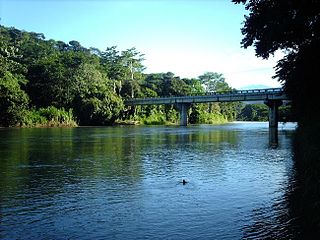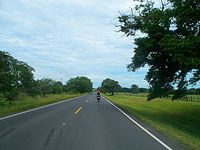
National Primary Route 4, or Route 4, is a national primary road, which covers the northern region of the country, through the provinces of Limón, Heredia, Alajuela and Guanacaste.

National Secondary Route 126, or just Route 126 is a National Road Route of Costa Rica, located in the Alajuela, Heredia provinces. It connects Route 3 and Route 4.

National Primary Route 35, or just Route 35 is a National Road Route of Costa Rica, located in the Alajuela province, and it is a road that serves the central north area of Costa Rica.

National Primary Route 32, or just Route 32 is a National Road Route of Costa Rica, located in the San José, Heredia, Limón provinces. It connects the central valley and Greater Metropolitan Area to the Caribbean coast of the country.

National Primary Route 27, or just Route 27 is a National Road Route of Costa Rica, is a route which connects the Greater Metropolitan Area to Caldera Port and the Pacific coast of the country.
National Secondary Route 106, or just Route 106 is a National Road Route of Costa Rica, located in the Heredia province. Is a parallel road north to a segment of Route 1.

National Primary Route 34, official name Carretera Pacífica Fernández Oreamuno, and popularly known as Carretera Costanera Sur, or just Route 34, is a National Road Route and scenic route of Costa Rica, located in the Alajuela, Puntarenas provinces that connects Route 27 and Route 2 mostly along the central and south Pacific coast of the country, and is the recommended route over the Pan-American Highway when traveling between the south of the country to the Greater Metropolitan Area.
National Primary Route 5, or just Route 5 is a National Road Route of Costa Rica, and it is a road from the area known as Tournón, in the triple limit of the Cinco Esquinas, Tibás district, Merced, San José district, and San Francisco, Goicoechea district in San José province to the Heredia district in the Heredia province of Costa Rica, and joins Route 108 and Route 3.
National Secondary Route 147, or just Route 147 is a National Road Route of Costa Rica, located in the San José, Alajuela provinces. It is locally known as either Radial Lindora, Radial San Antonio or Radial Santa Ana.
National Primary Route 36, or just Route 36 is a National Road Route of Costa Rica, located in the Limón province.
National Primary Route 3, or just Route 3 is a National Road Route of Costa Rica, located in the San José, Alajuela, Heredia provinces.
National Secondary Route 104, or just Route 104 is a National Road Route of Costa Rica, located in the San José province.
National Secondary Route 118, or just Route 118 is a National Road Route of Costa Rica, located in the Alajuela province.
National Secondary Route 135, or just Route 135 is a National Road Route of Costa Rica, located in the Alajuela province.
National Secondary Route 141, or just Route 141 is a National Road Route of Costa Rica, located in the Alajuela province.
National Secondary Route 142, or just Route 142 is a National Road Route of Costa Rica, located in the Alajuela, Guanacaste provinces.
National Secondary Route 169, or just Route 169 is a National Road Route of Costa Rica, located in the Alajuela province.
National Tertiary Route 702, or just Route 702 is a National Road Route of Costa Rica, located in the Alajuela province.
National Tertiary Route 703, or just Route 703 is a National Road Route of Costa Rica, located in the Alajuela province.
National Tertiary Route 704, or just Route 704 is a National Road Route of Costa Rica, located in the Alajuela province.











